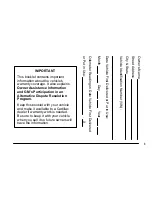
Every time you check inflation, you
should also examine the tires for
damage, foreign objects, and wear.
You should look for:
Bumps or bulges in the tread or
side of the tire. Replace the tire if
you find either of these conditions.
Cuts, splits, or cracks in the side
of the tire. Replace the tire if you
can see fabric or cord.
Excessive tread wear.
If you check air pressures when the
tires are hot [driven for several miles
(kilometers)], you will see readings 4
to 6 psi (30 to 40 kPa, 0.3 to 0.4
kgf/cm ) higher than the cold
readings. This is normal. Do not let
air out to match the recommended
cold air pressure. The tire will be
underinflated.
For additional information about
your tires, see page
.
For convenience, the recommended
tire sizes and cold tire pressures are
on a label on the driver’s doorjamb.
The following chart shows the
recommended cold tire pressures for
most normal and high-speed driving
conditions.
Never use a puncture-repairing agent
in a flat tire. If used, you will have to
replace the tire pressure sensor.
Have the flat tire repaired by your
dealer as soon as possible.
You should get your own tire
pressure gauge and use it whenever
you check your tire pressures. This
will make it easier for you to tell if a
pressure loss is due to a tire problem
and not due to a variation between
gauges.
While tubeless tires have some
ability to self-seal if they are
punctured, you should look closely
for punctures if a tire starts losing
pressure.
306
Tire Size
Cold Tire Pressure
Compact Spare
Front/Rear:
Tires
Tire Inspection
Recommended Tire Pressures
266
P245/65R17 105S
32 psi (220 kPa ,
2.2 kgf/cm )
60 psi (420 kPa ,
4.2 kgf/cm )
T165/90R17 105M
Содержание 2007 Ridgeline
Страница 60: ......
Страница 174: ...Compass 170 Zone Map Compass Display for Each Zone...
Страница 196: ......
Страница 236: ......
















































